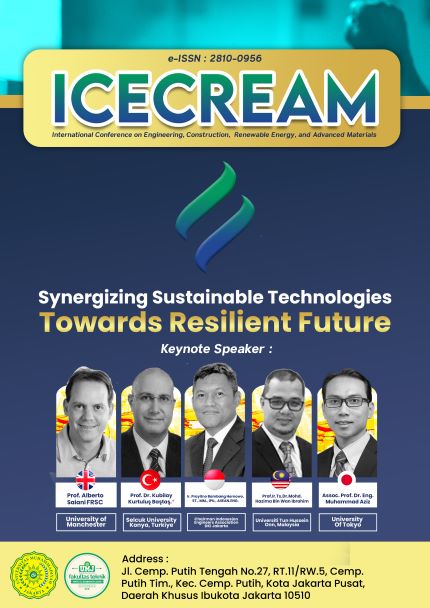Numerical Simulation of Effect the Geometrical Underlip on The Performance of Oscillating Water Column
Abstract
The development of water wave energy conversion especially Oscillating Water Column (OWC) continues to find the most optimal system. Using the CFD method, the research process becomes faster and more effective because one of the advantages of CFDs is the rapid prediction of phenomena with a numerical simulation approach. This research aims to increase efficiency of water wave energy conversion, especially OWC using CFD. Modifications were made to the OWC underlip with the model used in the experiment by Celik (2022). The models are rectangular model (as reference), rounded model, quarter circle model, front semi-circle model, back semi-circle model, and circle model. From the CFD simulation results, an increase in efficiency is obtained for each modification model. The optimal model is the circle model with an efficiency increase of 8.87% from the conventional underlip (rectangular) model. This is because the turbulent kinetic energy in the system can be reduced.Keywords: Oscilating Water Column, Underlip Geometry, Turbulence Kinetic Energy, Computational Fluid DynamicReferences
Carlo, L., Iuppa, C., & Faraci, C. (2023). A numerical-experimental study on the hydrodynamic performance of a U-OWC wave energy converter. Renewable Energy, 203, 89–101.
Çelik, A. (2022). An experimental investigation into the effects of front wall geometry on OWC performance for various levels of applied power take off dampings. Ocean Engineering, 248.
Fleming, A. N., & Macfarlane, G. J. (2017). Experimental flow field comparison for a series of scale model oscillating water column wave energy converters. Marine Structures, 52, 108–125.
Mandev, M. B., & Altunkaynak, A. (2023). Cylindrical frontwall entrance geometry optimization of an oscillating water column for utmost hydrodynamic performance. Energy, 280.
Mohapatra, P., Vijay, K. G., Bhattacharyya, A., & Sahoo, T. (2023). Influence of distinct bottom geometries on the hydrodynamic performance of an OWC device. Energy, 277.
Qu, M., Yu, D., Xu, Z., & Gao, Z. (2022). The effect of the elliptical front wall on energy conversion performance of the offshore OWC chamber: A numerical study. Energy, 255.
Wang, C., & Zhang, Y. (2021). Numerical investigation on the wave power extraction for a 3D dual-chamber oscillating water column system composed of two closely connected circular sub-units. Applied Energy, 295.
McChormick (1981). Ocean Wave Energy Conversion. Annapolis: Maryland: ept of Naval Systems Engineering, U.S Naval Academy

